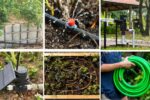Few things say summer like biting into a juicy, chilled slice of watermelon on a hot afternoon. If you’ve ever wished you could grow your own crop of these sweet, refreshing fruits, you’re in luck! Watermelons are surprisingly easy to grow in a home garden with a little space, sunshine, and the right care. In this comprehensive guide, we’ll walk you through how to plant watermelon seeds, nurture them through the growing season, and enjoy a delicious harvest.

Why Grow Watermelons at Home?
Watermelons aren’t just a summer staple — they’re also:
- Fun to grow: Watching vines sprawl and fruits swell is rewarding.
- Customizable: Choose from dozens of heirloom and hybrid varieties.
- Healthful: Packed with vitamins A and C, antioxidants, and hydration.
- A family favorite: Kids love tending and harvesting these giant fruits.
Even better, homegrown watermelons are often sweeter and fresher than store-bought ones.
When to Plant Watermelon Seeds
Watermelons love warmth. These sun-loving plants require consistently warm soil and long growing seasons.
Best Planting Time:
- Spring to early summer, after the last frost date.
- Soil temperatures should be at least 70°F (21°C).
- In cooler climates, start seeds indoors and transplant after frost danger passes.
Tip: Use a soil thermometer for accuracy — watermelon seeds won’t sprout well in cold soil.
Choosing the Right Watermelon Variety
There’s more than one kind of watermelon! Choose a type that suits your climate, taste preferences, and available space.
Popular Varieties:
- Sugar Baby: Small, round, early harvest (65-75 days)
- Crimson Sweet: Classic flavor, medium-sized, disease-resistant
- Charleston Gray: Oblong, large, juicy, good for hot regions
- Golden Midget: Tiny, yellow-skinned, quick-growing
- Moon and Stars: Heirloom with speckled skin, rich taste
Check your local nursery or seed catalog for regionally recommended types.
What You’ll Need
Supplies:
- Watermelon seeds
- Fertile, well-draining soil
- Compost or organic fertilizer
- Garden tools (hoe, shovel)
- Mulch (optional)
- Water source (hose or watering can)
- Trellis (optional for small, personal-sized varieties)

How to Plant Watermelon Seeds
Watermelons grow best from direct-sown seeds, though you can also start them indoors in colder areas.
Step-by-Step Guide:
1. Prepare the Soil:
- Choose a sunny, open space with 8+ hours of direct sunlight daily.
- Watermelons prefer loamy, well-drained soil rich in organic matter.
- Amend soil with compost or aged manure before planting.
- Aim for a soil pH between 6.0 and 6.8.
2. Create Mounds or Hills:
- Watermelons thrive on raised mounds, which warm faster and drain well.
- Make hills about 1–2 feet wide and 6 inches tall.
- Space mounds 3–6 feet apart for full-size varieties, or 2–3 feet for mini types.
3. Plant the Seeds:
- Sow 3–5 seeds per mound, about 1 inch deep.
- Cover lightly with soil and water gently.
- Once seedlings have sprouted, thin to the 2 strongest plants per hill.
Watering and Care Tips
Watermelon plants need regular care to grow big, sweet fruits.
Watering:
- Keep soil consistently moist but not soggy.
- Water deeply once or twice a week, about 1–2 inches per week.
- Avoid overhead watering to prevent fungal issues — aim water at the base.
Important: Cut back on watering when fruits begin to ripen to concentrate sweetness.
Feeding:
- Use a balanced organic fertilizer when planting.
- Once vines start running, switch to a fertilizer higher in phosphorus and potassium to encourage fruiting.
- Avoid overfeeding with nitrogen — too much leads to big vines but small fruits.
Mulching:
- Apply a layer of organic mulch (straw, dried leaves) around plants.
- Helps conserve moisture, suppress weeds, and regulate soil temperature.

Supporting the Vines (Optional)
Watermelon vines sprawl extensively — some can grow up to 20 feet long! If space is limited:
- Use a sturdy trellis for small varieties.
- Support growing fruits with slings or nets to prevent stem breakage.
Common Pests and Problems
Like all garden crops, watermelons attract a few pests and diseases.
Pests:
- Aphids
- Cucumber beetles
- Squash bugs
Solution: Use insecticidal soap, neem oil, or companion plant with marigolds or nasturtiums.
Diseases:
- Powdery mildew
- Fusarium wilt
- Anthracnose
Solution: Ensure good air circulation, avoid overhead watering, and rotate crops each season.
How to Know When Watermelons Are Ready to Harvest
Timing the harvest is critical — too soon, and the melon will lack flavor; too late, and it may split.
Signs of Ripeness:
- Tendrils near the stem turn brown and dry
- The underside (ground spot) changes from white to creamy yellow
- The skin becomes dull and hard
- A hollow sound when tapped
Tip: Use a combination of these signs for best results.
How to Harvest
- Use garden shears or a sharp knife to cut the melon from the vine.
- Leave a few inches of stem attached to prolong freshness.
- Handle gently to avoid bruising.

Storing and Enjoying Your Harvest
- Whole watermelons can be stored in a cool, shaded area for up to 2 weeks.
- Once cut, refrigerate leftovers wrapped or in containers for up to 4–5 days.
- Watermelons can also be frozen (cubed or balled) for smoothies and desserts.
Fun Watermelon Growing Ideas
- Watermelon Patch Party: Host a summer gathering to harvest and share your bounty.
- Watermelon-Themed Recipes: Try fresh salads, chilled soups, or frozen treats.
- Garden Projects with Kids: Let children plant and decorate their own watermelon hills.
Final Thoughts
Growing watermelons from seed isn’t just for expert gardeners — it’s an accessible, rewarding, and delicious adventure for anyone with a sunny garden plot or spacious backyard. With the right preparation, care, and timing, you can enjoy plump, juicy fruits bursting with summer sweetness.
Whether you opt for a classic Crimson Sweet, a petite Sugar Baby, or a quirky Moon and Stars heirloom, planting watermelon seeds is one of the most satisfying ways to celebrate the growing season.
So, grab a pack of seeds, roll up your sleeves, and get ready to grow your own sweet summer treats!





Leave A Comment